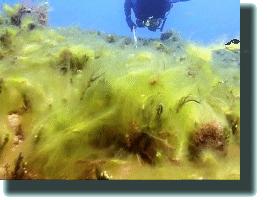
| We are having another cladophora bloom 32K JPEG |
For our first few dives, the water was a tad murky. We'd arrived just as a swell had left. Then something else became obvious. We are having another cladophora bloom--our third year in a row.

| We are having another cladophora bloom 32K JPEG |
Once we paid attention, we saw that the brown hairy-fuzz, Lyngbya majuscula, has also checked in for another summer, new tufts already setting up shop in the sand and on any available coral rubble.
The brown hairy-fuzz, Lyngbya majuscula, has also checked in for another summer 63K JPEG | 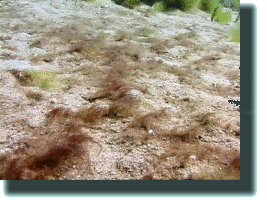
|
After twelve dives we have identified 63 green turtles (honu) and a Hawaiian hawksbill ('ea). Yes, Keoki made an early appearance and acted like no time had passed between us. We found her sniffing about Reef 1 in foraging-mode looking for a tastie. It was wonderful to see a Hawaiian hawksbill again.
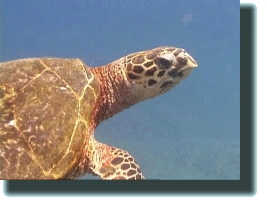
| It was wonderful to see a Hawaiian hawksbill again 36K JPEG |
As special as 'ea are, however, the honu are the story.
Last March George Balazs returned to Honokowai to capture Polzbarney and to help him. George emailed us and wrote:
"Four tumors selected for the cryo treatment. Three treatments for each with slow thaw (takes a long time)... He is not emaciated, not even the suggestion of 'skinny.'
"But during careful inspection, Denise and I both noticed Polzbarney's left eye not opening. A closer look revealed that the eyeball was deflated, destroyed."
We thanked George and informed him that we had resigned ourselves to lose Polzbarney to fibropapilloma disease, and that if Polzbarney follows the fibropapilloma "schedule" of other juvenile turtles, the summer 1999 was his last on Honokowai reef and we didn't expect to see our friend in Summer 2000.
George's response? We're letting George Balazs have the last word here--with our gratitude.
"...Over here we're working hard on several fronts to make your predictions not come true. The course of the future can be changed."
So it was. The tumors George had "frozen" have not regrown. Still, the primary tumor on Polzbarney's right shoulder is far worse than when we last saw it. Our honu-friend remains robust, however--or as George would say, "...is not emaciated, not even the suggestion of 'skinny.'"
Our honu-friend remains robust, however 45K JPEG | 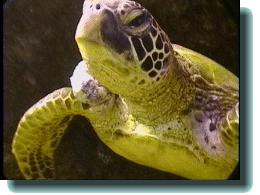
|
Last summer we reported on a remarkable turtle that we named "Kiholo", a turtle who'd travelled all the way from the Big Island of Hawaii to our dive site at Honokowai. Once we read the turtle's tag, George Balazs was able to share historical information on this special turtle.
His records showed that Kiholo was first tagged in March 1989 and has been resighted twelve times since, the last being October 1996. Last summer, almost three years later, Kiholo was sighted by us at Honokowai.
This animal should have stayed in Kiholo Bay. Of the hundreds of turtles George and his team have pulled from that area, none have ever had tumors. Kiholo Bay on Hawaii's Kona Coast is fibropapilloma free. Honokowai is not.
Here is what we wrote about Kiholo last summer:
"Sadly, Kiholo is now sick. The posterior of the turtle's left eye is showing a pre-eruptive tumor and white spots fleck his neck, a possible harbinger of a tumor collar. We have little doubt that if Kiholo stays at Honokowai, his condition will worsen."
Here's a comparison of Kiholo's left eye last summer, and then eleven months later. His condition did indeed worsen.
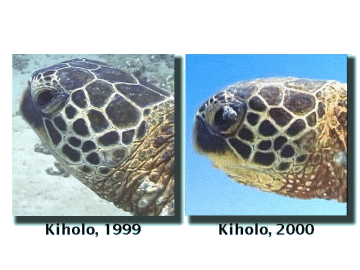
| Comparison of Kiholo's left eye last summer, and then eleven months later 45K JPEG |
In 1998, we wrote about meeting a new little honu. She was beautiful. She needed a name, so we went to our Hawaiian dictionary. (We typically do this when we decide a honu should be named.) We called her Makana, Hawaiian for "gift." Makana is a gift from the Shoals, the nesting grounds for the Hawaiian green sea turtle. Since naming her, we've had many enjoyable interactions with Makana.
Since naming her, we've had many enjoyable interactions with Makana 46K JPEG | 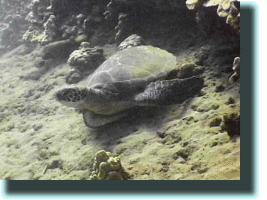
|
Here is some of what we wrote back in 1998:
"Yet there is sadness. If Makana continues to call Honokowai home, she, like all the other 'recruits' (the very young who settle into an area), will become sick with fibropapilloma tumors within two to three years.
"Then, like all the other youngsters before her, Makana's condition will worsen and she too will disappear from our lives."
Well, we resighted Makana this week and here is what she looks like now.
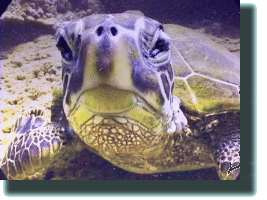
| We resighted Makana this week and here is what she looks like now 53K JPEG |
If there's one thing you can say about fibropapilloma disease. It's predictable.
An eagle ray swims over a honu at Reef2 47K JPEG | 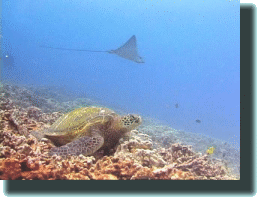
|
Saturday morning dive, on our way back to shore. We sight Tutu (known since 1990) swimming upcurrent. Spectacular really, like watching a wine keg with flippers. Then, something protruded from Tutu's tail and settled onto the corals. It was a foot-long turd--turtle feces actually.
Up to then, we'd seen turtle feces every year--but none this impressive. This was the Guiness Book of Records turtle turd. So Ursula picked it up and Peter videotaped it for posterity.
This was the Guiness Book of Records turtle turd 53K JPEG | 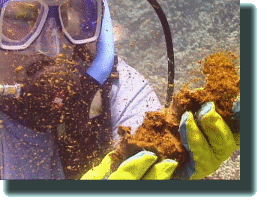
|
Proof positive that there is nothing about a Hawaiian green sea turtle we don't find "of interest"!
 Who's Who Underwater at Honokowai
Who's Who Underwater at Honokowai